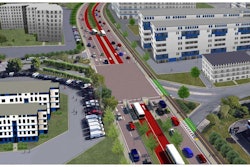
The U.S. Department of Transportation’s Federal Highway Administration (FHWA) today announced a final rule that will improve safety for all road users by ensuring that pavement markings are made more visible in dark or low light conditions. There are countless reasons this move can be interpreted as a positive move, not only for general motorists, but for pedestrians and bicyclists, as well, because the standard will apply to other types of paved roadways besides the highway systems.
New Standards Raise the Bar
The use of "retroflective" substances in road striping is far from being new. Its use is ubiquitous. The layman drives down any public city streets and they see it, even if they don't register that it is responsible for that bright shinning light bouncing back at them from their headlights in the dark. The questions is, then, if the product here is common: what is this final ruling about?
The Manual on Uniform Traffic Control Devices for Streets and Highways (MUTCD), the national standard for traffic control devices used on all streets, highways, bikeways, and private roads open to public travel, currently requires that pavement markings be visible at night and that all markings on interstate highways be retroreflective. However, what's key to this new change, is that the current language regarding visibility/retroreflectivity does not require a measurable minimum level.
FHWA believes, by setting forth this updated universal standard, state and local transportation agencies can reduce the number of severe crashes that happen in dark, unlighted conditions and result in severe nighttime collisions. If their expectations are met, the hope is a reduction in the annual fatality rate that is roughly three times the daytime fatality rate. If that number comes down, everybody wins.
“FHWA’s number one goal is to reduce highway fatalities and serious injuries wherever and whenever they occur,” Acting Federal Highway Administrator Stephanie Pollack said. “This rule will save lives by helping those traveling see pavement markings more clearly and know what lies ahead, especially in darkness and other instances when visibility is critical.”
Implementation
Under the final rule, the MUTCD will provide this minimum standard for pavement marking retroreflectivity effective September 6, 2022. The rule is also expected to help reduce said crashes by enhancing the ability of advanced driver assistance and autonomous vehicle technologies to identify pavement markings more readily. Though, it should be noted, those technologies are still developmental and these upgraded markings do not fully ensure those systems will operate without incident.
While it does require state and local agencies or officials to implement a method within four years for maintaining pavement marking retroreflectivity at or above minimum levels, the pavement marking improvements are eligible for up to 100 percent Federal-aid funding. This should ease some of the immediate concerns about changes to costs associated with the updated demands of the law.
Today’s rule is the latest action taken by FHWA to reduce roadway fatalities and serious injuries as part of the U.S. Department of Transportation’s National Roadway Safety Strategy unveiled earlier this year. A comprehensive update of the entire MUTCD is also required under the Bipartisan Infrastructure Law and work on that update, in the form of the 11th Edition of the MUTCD, is currently underway by FHWA and required to be completed by May 2023. The Retroreflective Pavement Markings final rule announced today (Revision 3 to the 2009 Edition of the MUTCD) will be included in the 11th Edition.
The FHWA Retroreflective Pavement Marking final rule can be read in the Federal Register.




















